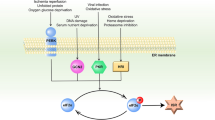Abstract
Stress granules (SGs) are large ribonucleoprotein (RNP)-containing particles that form in cytoplasm in response to a variety of acute changes in the cellular environment. One of the general parameters of the cell environment is pH. In some diseases, as well as in muscle fatigue, tissue acidosis occurs, leading to decrease in intracellular pH. Here we studied whether decrease in pH causes the formation of SGs in cultured animal cells, whether it affects the formation of the SGs under the action of arsenite and, if such effects occur, what are the mechanisms of the influence of acidosis. Acidosis was simulated by decreasing the pH of the culture medium, which acidified the cytoplasm. We found that medium acidification to pH 6.0 in itself did not cause formation of SGs in cells. Moreover, acidification prevented the formation of SGs under treatment with sodium arsenite or sodium arsenite together with the proteasome inhibitor MG132, and it inhibited the dissociation of preformed SGs under the influence of cycloheximide. We established that pH decrease did not affect the phosphorylation of eIF2α that occurs under the action of sodium arsenite, and even caused such phosphorylation by itself. We also found that the velocity of SG motion in cytoplasm at acidic pH was very low, and the mobile fraction of SG-incorporated PABP protein revealed by FRAP was decreased. We suppose that acidic pH impairs biochemical processes favoring assembly of RNPs in stress conditions and RNP dissociation on the termination of stress. Thus, in acidosis the reaction of the cellular translation apparatus to stress is modified.
Similar content being viewed by others
Abbreviations
- FRAP:
-
fluorescence recovery after photobleaching
- RNP:
-
ribonucleoprotein
- SG:
-
stress granule
References
Rehncrona, S. (1985) Ann. Emerg. Med., 14, 770–776.
Kraig, R. P., and Chestler, M. J. (1990) Cerebr. Blood Flow Metab., 10, 104–114.
Sahlin, K., Harris, R. C., and Hultman, E. (1975) Biochem. J., 152, 173–180.
Anderson, P., and Kedersha, N. (2006) J. Cell Biol., 172, 803–808.
Buchan, J. R., and Parker, R. (2009) Mol. Cell, 36, 932–941.
Kedersha, N., Chen, S., Gilks, N., Li, W., Miller, I. J., Stahl, J., and Anderson, P. (2002) Mol. Biol. Cell, 13, 195–210.
Farrell, P. J., Balkow, K., Hunt, T., Jackson, R. J., and Trachsel, H. (1977) Cell, 11, 187–200.
Kedersha, N., Cho, M., Li, W., Yacono, P., Chen, S., Gilks, N., Golan, D., and Anderson, P. (2000) J. Cell Biol., 151, 1257–1268.
Loschi, M., Leishman, C. C., Berardone, N., and Boccaccio, G. L. (2009) J. Cell Sci., 122, 3973–3982.
Nadezhdina, E. S., Lomakin, A. J., Shpilman, A. A., Chudinova, E. M., and Ivanov, P. A. (2010) Biochim. Biophys. Acta, 1803, 361–371.
Bartoli, K. M., Bishop, D. L., and Saunders, W. S. (2011) Int. J. Cell Biol., 2011, 939848.
Ivanov, P. A., Chudinova, E. M., and Nadezhdina, E. S. (2003) Exp. Cell Res., 290, 227–233.
Kolobova, E., Efimov, A., Kaverina, I., Rishi, A. K., Schrader, J. W., Ham, A. J., Larocca, M. C., and Goldenring, J. R. (2009) Exp. Cell Res., 315, 542–555.
Dorovkov, M. V., Pavur, K. S., Petrov, A. N., and Ryazanov, A. G. (2002) Biochemistry, 41, 13444–13450.
Shanins, N. A., Ivanov, P. A., Chudinova, E. M., Severin, F. F., and Nadezhdina, E. S. (2001) Mol. Biol. (Moscow), 35, 638–646.
Anderson, P., and Kedersha, N. J. (2002) Cell Sci., 115, 3227–3234.
Isozaki, U., Mitch, W. E., England, B. K., and Price, S. R. (1996) Proc. Natl. Acad. Sci. USA, 93, 1967–1971.
Chernov, K. G., Barbet, A., Hamon, L., Ovchinnikov, L. P., Curmi, P. A., and Pastre, D. (2009) J. Biol. Chem., 284, 36569–36580.
Vantelon, N., Rioux-Bilan, A., Ingrand, S., Pain, S., Page, G., Guillard, O., Barrier, L., Piriou, A., and Fauconneau, B. (2007) Eur. J. Neurosci., 26, 689–700.
Carlberg, U., Nilsson, A., and Nygard, O. (1990) Eur. J. Biochem., 191, 639–645.
Gilks, N., Kedersha, N., Ayodele, M., Shen, L., Stoecklin, G., Dember, L. M., and Anderson, P. (2004) Mol. Biol. Cell., 15, 5383–5398.
Kwon, S., Zhang, Y., and Matthias, P. (2007) Genes Dev., 21, 3381–3394.
Fujimura, K., Katahira, J., Kano, F., Yoneda, Y., and Murata, M. (2009) Biochim. Biophys. Acta, 1793, 1728–1737.
Cooper, J. R., and Wordeman, L. (2009) Curr. Opin. Cell Biol., 21, 68–73.
Ohn, T., Kedersha, N., Hickman, T., Tisdale, S., and Anderson, P. (2008) Nat. Cell Biol., 10, 1224–1231.
Ohn, T., and Anderson, P. (2010) Wiley Interdiscip. Rev. RNA, 1, 486–493.
Author information
Authors and Affiliations
Corresponding author
Additional information
Original Russian Text © E. M. Chudinova, E. S. Nadezhdina, P. A. Ivanov, 2012, published in Biokhimiya, 2012, Vol. 77, No. 11, pp. 1526–1535.
Originally published in Biochemistry (Moscow) On-Line Papers in Press, as Manuscript BM12-154, October 7, 2012.
Rights and permissions
About this article
Cite this article
Chudinova, E.M., Nadezhdina, E.S. & Ivanov, P.A. Cellular acidosis inhibits assembly, disassembly, and motility of stress granules. Biochemistry Moscow 77, 1277–1284 (2012). https://doi.org/10.1134/S0006297912110065
Received:
Published:
Issue Date:
DOI: https://doi.org/10.1134/S0006297912110065




